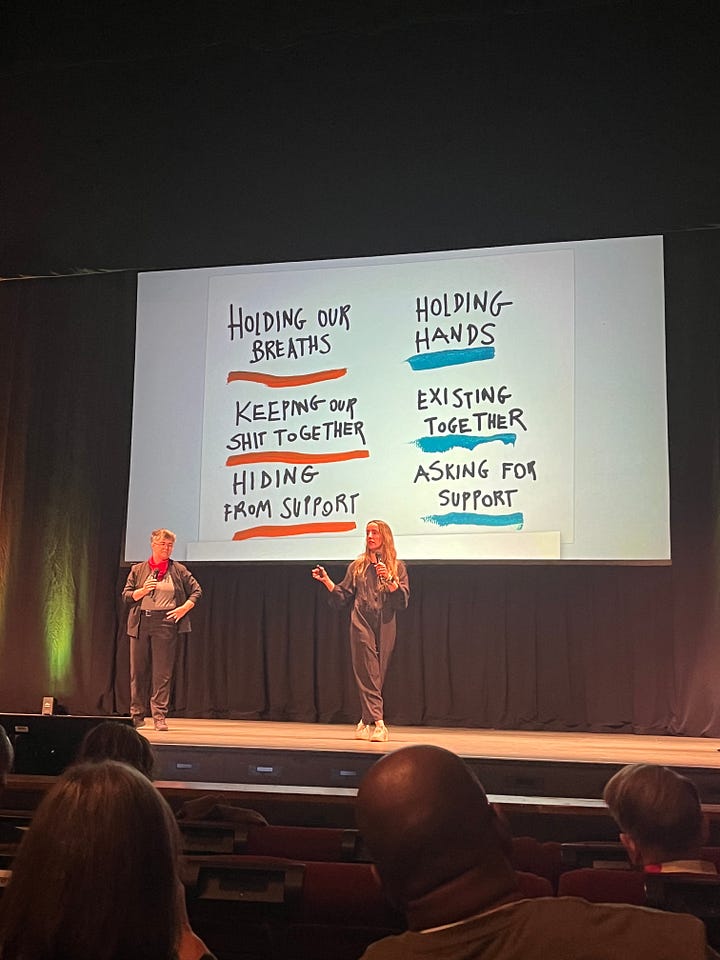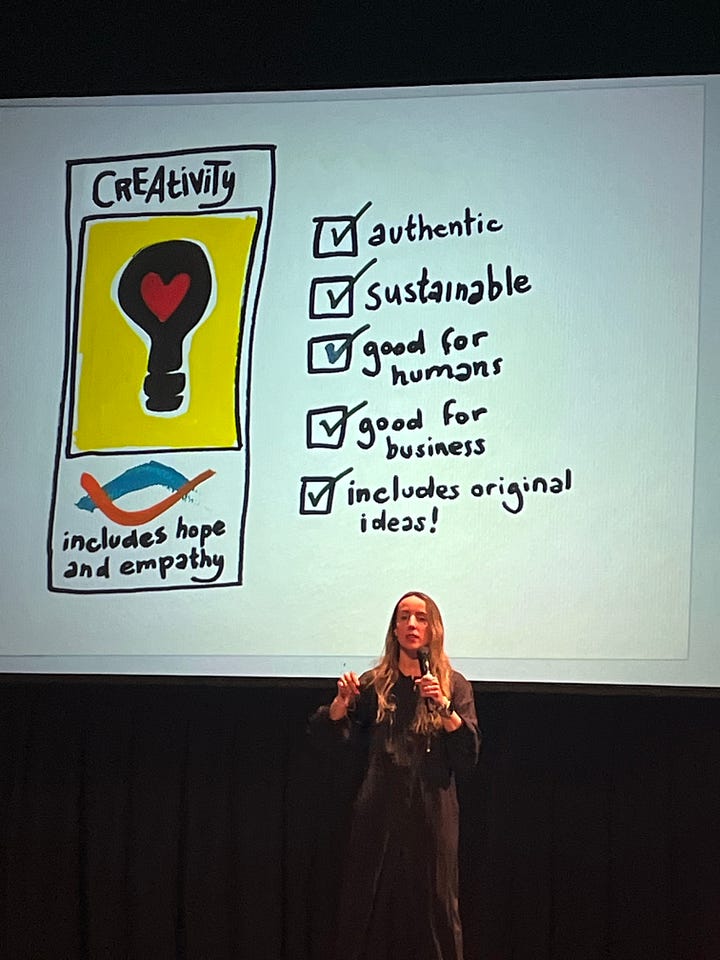Empathy is a team sport.
Are we more empathetic in groups? A flight, a conference, and some new research offer three lessons for leaders...and anyone who works on a team.
Hoodie up. Headphones in position. Tray table locked. I’m ready for takeoff. I smile at my seat mates as we settle in, but once in my airplane cocoon, I definitely give off the don’t-talk-to-me vibes.
When I arrive in Denver at the HOW Design Live conference, a new me emerges. I can’t wait to meet my fellow conference-goers and learn everything I can about them. I strike up conversations in the check-in line and in the session spaces. Who is this person? Am I disingenuous? Selectively friendly? Un-empathetic?
Both situations contain large groups of strangers sitting in rows, yet I show up so differently. Maybe the purpose, the people, and the environment matter more than I thought.
The whole purpose of the HOW conference is to bring people together with shared interests in an environment designed for connection. The airplane brings people together who just need to get from point A to point B.
At HOW,
of Make the Sun got us out of our seats, dancing at 10am in the morning. She not only ignited our creative energy for the day, she broke down the social walls — how can you not feel closer to the people around you when you’re shaking your booty before noon?On the plane, the flight attendants announce (terrifying) safety instructions over a choppy PA system.
At HOW, Diego Guevara, Senior Global Designer at Nike, didn’t just share his incredible designs and his path to purpose and passion, he left us with the reminder to savor the experience of being at this conference and to meet as many people as we can while we’re here. Through his examples, he showed us the value that connections have had in his life and career.
On the airplane, we’re told to “keep your seat belt fastened low and tight across your lap.”
At HOW,
and Brandi Parker blew our minds with their handcrafted presentation that beautifully weaved together messages of creativity, sustainability, and a hopeful, empathetic future. They encouraged us to think of ourselves, as well as everything we create, as part of a sustainable, interdependent ecosystem that relies on us existing together.

So, while we’re actually physically closer with other humans on an airplane (especially in coach) than we are at a conference, we are emotionally more distant. Connecting with others is very much impacted by:
Our reason for being there
The messages and signals we’re getting from everyone around us
These two things are key to how we relate, interact, and empathize with one another. And just as that little lightbulb came on for me, the Scientific American article, “Being Empathetic is Easier When Everyone’s Doing It” came across my radar. This groundbreaking article shows, by citing numerous studies, that empathy is socially motivated. The findings have great implications for how we think about empathy in our work and in our lives.
The three things I learned shape how I think about empathy in marketing and leadership.
#1 Empathy is key to survival.
FROM THE ARTICLE: “Our ability to perceive other people’s inner states most likely evolved because it helps to forge the kinds of strong social ties that promote survival. In human ancestral environments, nomadic groups understood one another’s emotions and state of mind; the bonds among them deepened, helping the group to function as a resilient unit.”
TAKEAWAY FOR LEADERS: If your department or your entire organization isn’t functioning well together as a unit, empathy can help. Everyone on your team has the capacity for empathy, but it takes leaders to make empathy a priority, both through their example and through the environment they foster to build a more resilient and connected culture.
#2 Empathy decreases when we are experiencing pain or stress.
FROM THE ARTICLE: “In one 2020 study at the University of Liverpool in England, researchers found that empathy for others’ pain requires a host of different brain networks to interact, including some responsible for inferring others’ mental state. (When people perceive their own pain, on the other hand, their brain activity related to understanding others diminishes.)”
TAKEAWAY FOR LEADERS: If hair-on-fire stress and fear of making a mistake are the norms in your organization, then empathy can’t flourish. Empathy for coworkers, customers, partners…and really anyone your organization serves, will be diminished if everyone is always in high-stress, high-fear mode. Basically, our nervous system gets hijacked by stress and fear which means we can’t show up as our best, most empathetic and creative selves.
#3 Empathy begets more empathy.
FROM THE ARTICLE: “In a 2024 study led by neuroscientist Grit Hein of Germany’s University Hospital Würzburg, adult subjects watched videos of people getting hit with an intense burst of air and reacting in pain. People who watched a person respond empathically to the blast videos were likely to follow suit, whereas those who watched another person shrug off the videos acted equally blasé.”
TAKEAWAY FOR LEADERS: When we’re surrounded by empathetic people, we are more likely to be empathetic. On the flip side, when negative behaviors like hostility, disrespect, and exclusion are tolerated in your culture, people are apt to mirror that social example. What type of interactions do you foster in your culture? What do you tolerate? Chances are you’ll continue to see more of whatever is already present - good or bad - unless you take action.
Empathy can be a team sport in your organization.
Whether you’re the CEO, CMO, marketing director or a contributing team member, what you do matters for creating an empathetic environment. If you want the people around you to show up with purpose and energy for connecting with one another and with your customers, there needs to be an intention around empathy—and this includes putting systems in place that cultivate a culture of empathy.
If any of this resonates with you, please put a message in the comments. I’m here on Substack to connect with other empathetic marketers and leaders interested in making the places we work and live a little better for all. I’d love to hear from you - Where is empathy present in your work? Where is it missing?
Pictured in the cover photo: Jack Prettyman (left), Jamie Cox (right), and me (in the middle).






Thanks so much for including me! Wonderful article and i couldn’t agree more: empathy is a team sport.